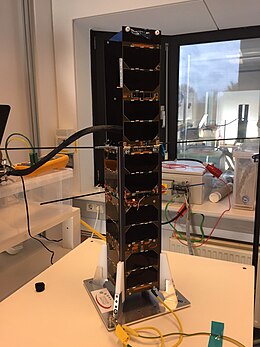This article needs additional citations for verification. (September 2021) |
 | |
| Mission type | Astronomy · Planetary science |
|---|---|
| Operator | Observatoire de Paris · CNRS |
| COSPAR ID | 2018-004W |
| SATCAT no. | 43132 |
| Website | http://picsat.obspm.fr |
| Mission duration | ~1 year |
| Spacecraft properties | |
| Bus | CubeSat 3U |
| Manufacturer | ISIS (spacecraft) Hyperion (ADCS) LESIA (payload) |
| Launch mass | 3.9 kg |
| Dimensions | 10 × 50 × 100 cm with antennas and solar panels |
| Power | 6 watts |
| Start of mission | |
| Launch date | 12 January 2018, 03:58 UTC |
| Rocket | PSLV |
| Launch site | SDSC |
| Contractor | ISL · ANTRIX |
| End of mission | |
| Last contact | 20 March 2018 |
| Decay date | 3 October 2023 |
| Orbital parameters | |
| Reference system | Geocentric |
| Regime | Low Earth · SSO |
| Inclination | 97.3° |
| Period | 95 minutes |
| Main telescope | |
| Type | Off-axis telescope |
| Diameter | 50 mm |
| Focal length | 150 mm |
| Focal ratio | f/4 |
| Wavelengths | visible light |
| Transponders | |
| Band | VHF · UHF |
PicSat was a French observatory nanosatellite, designed to measure the transit of Beta Pictoris b, an exoplanet which orbits the star Beta Pictoris.
PicSat was designed and built by a team of scientists led by Dr. Sylvestre Lacour, astrophysicist and instrumentalist at the High Angular Resolution in Astrophysics group in the LESIA laboratory with Paris Observatory, Paris Sciences et Lettres University and the French National Centre for Scientific Research (CNRS). It was launched on 12 January 2018, and operated for more than 10 weeks before falling silent on 20 March 2018.[1] The cubesat decayed from orbit on 3 October 2023.[2]
- ^ "Bye bye PicSat (for now)". PicSat. Retrieved 28 July 2019.
- ^ "PICSAT". N2YO.com. 3 October 2023. Retrieved 2 December 2023.